|








| |
|
The LiSA loudspeaker system delivers high quality sound reinforcement of music and
speech. It can be applied to all types of large events, including rock/pop
concerts, orchestral arrangements, opera and corporate presentations. The system is comprised of several highly directive 3-way loudspeaker
modules. The LiSA system has been custom created exclusively for Laboratorio Musica, designed from scratch by the LiSA Design
Workgroup.The LiSA loudspeaker system delivers high quality sound reinforcement of music and
speech. It can be applied to all types of large events, including rock/pop
concerts, orchestral arrangements, opera and corporate presentations. The system is comprised of several highly directive 3-way loudspeaker
modules. The LiSA system has been custom created exclusively for Laboratorio Musica, designed from scratch by the LiSA Design
Workgroup.
|
Key Features
|
-
Designed for very Long-throw applications.
-
The system is full range. Two direct radiation 18” woofers reproduce low end down to 32 Hz, making additional sub woofers unnecessary in many
applications.
-
Optional very high power sub woofers, incorporating three long excursion 18” woofers each, are available when extra VLF energy is
required.
-
Very low distortion Neodymium StageAccompany Ribbon Compact Driver (TM) deliver extremely natural and high definition high frequency sound.
-
Cylindrical High Frequency source (Ribbon Driver) provides true line source array radiation at high
frequency.
-
Premium 18 Sound custom cone transducers incorporate the most advanced technologies: Double Demodulating Ring (DDR), Double Silicon Spider (DSS), Interleaved Sandwich Voice-Coil (ISV) and a custom weatherproof
protection.
-
Two horn loaded 10” midrange speakers perform higher vertical control in the midband, minimizing unwanted lobes respect to direct radiating
transducers.
-
Integrated stainless steel suspension system permits quick and reliable array hanging of up to 16
modules.
-
Advanced ultra-damped construction for best dampening of structural ringing modes and transducer
decoupling.
|
|
System Overview
|
|
Each LiSA Line Array module is a full bandwidth, high performance, high power 3 way loudspeaker system. The modules are designed to couple coherently when arrayed in a large number in a Vertical Line Array, creating a continuous radiating ribbon. This allows the vertical coverage of the whole system to be configured as desired, whilst the horizontal coverage remains that of the single module -a nominal 90°. As a result, vertical coverage, SPL and frequency response over the intended coverage area are fully predictable, minimizing the problems associated with traditional arrays, such as comb filtering and lobing problems. In fact, opposite to traditional arrays, these problems reduce as the number of speaker modules built into the array increase. The high frequency cylindrical radiation obtained using the Ribbon Drivers give the system a unique attenuation property. That being, when arrayed flat, a doubling in the distance from the module causes SPL to drop by only 3dB -substantially less than traditional arrays- resulting in a greatly improved fidelity and intelligibility, even under highly reverberant acoustic conditions. |
|
The Design
|
|
The LiSA system was designed and engineered using the most advanced modeling, analysis and measuring methods. During the modeling stage, many different techniques were incorporated. Finite element analysis, measurement analysis through proprietary tools and 3D modeling of the waveguides using stereolitography, are some of the advanced techniques used. Great attention was given to build the cabinets resonance free to avoid ringing modes and unwanted level dependent colouration. This was achieved using a very rigid braced enclosure and by filling all the unused internal cavities with polyurethane foam.
|
|
The Components
|
|
The system is equipped with two direct radiating 18” speakers for the low end –ranging from 32 Hz up to 150 Hz. These transducers incorporate some particular technologies. The cones are custom carbon fiber reinforced and custom coated to make them completely waterproof. Dual layer ISV Aluminum Voice coils, internally and externally wound, have been used. The double winding increases the coils cooling capacity two fold and consequently the power compression level is no more than 2.4 dB at full power -approximately half that of a conventional transducer.
Due to the roughness of the transducer and the Double Silicon Spider (DSS) this woofer -rated with a maximum continuous power of 600W AES, can handle short peaks 10 dB higher (6000W) without damage. Plus, by using flux demodulating, harmonic distortion is greatly reduced.
DDR technology (Double Demodulating Ring) uses two demodulating rings, reducing significantly the distortion and provides the voice coil with an extra cooling surface.
The mid band is catered for by two 10” horn loaded midbass transducers -working from 150Hz to about 1100Hz.
This 10” midbass unit is a very efficient, light moving mass transducer, with an overhung aluminum voice coil providing very high levels of undistorted power.
Double surface custom coating makes it waterproof and dampens the diaphragm at the same time.
The patented StageAccompany’s high frequency unit is a very special transducer. It provides a very natural cylindrical source and an accurate approximation of an isophasic line source. This gives the LiSA module a very close to cylindrical source at high frequencies from about 1100Hz upward.
Moreover, as it has no inherent internal compression, this component shows a harmonic and intermodulating distortion level of about one tenth than that of widely used compression drivers. This allows the Ribbon Compact Driver to deliver a high level of incredibly natural, well-defined sound in the high frequencies.
|
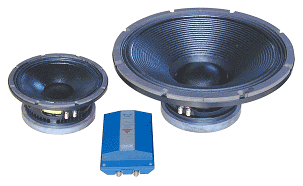
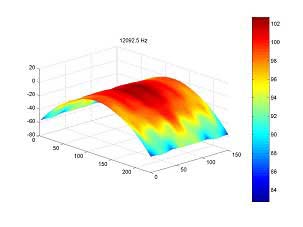
|
|
The System |
|
Performance predictability makes the LiSA system a really powerful tool for a system engineer. The LiSA array is a variable curvature line source array enabling the user to match the vertical coverage requirement to that of the particular audience being addressed. Up to 16 boxes can be hung in a single array. Great care and accuracy should be adopted when calculating the hanging height and position of the system.
Particularly critical is the speaker module aiming that must be accurately considered from venue to venue. It can be precisely addressed using the integrated precision mechanical hanging system. Many different element-to-element angle combinations are possible: 0°, 0.5°, 1°, 2°, 3°, 4°, 5°, 6°, 8° and 10°.
Specific custom calculation tools and simulation software have been developed for this purpose. As such, trained and qualified technicians equipped with all of the required tools and software carry out the systems
installation.
|

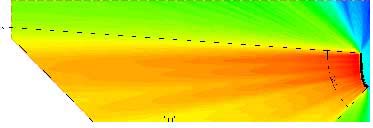
|
|
Processing and Amplifiers
|
|
The LiSA system is designed to be used in conjunction with a digital signal-processing unit (DSP) that assures all the filtering, alignment and Eq needed for optimal functioning. The processing tool currently being used is the Crown USM810 digital matrix processor, one of the most powerful digital processors currently available on the market. It features 4 SHARC (TM) DSP and externally controlled by the IQ (TM) software running under Windows 98 (TM). It is an 8 input 10 output digital processor using 24 bit AD and DA converters. An Avalon VT 747 Stereo Vacuum Tube Compressor performs system main power limiting, instead of the more commonly used digital compression systems. This provides safe, smooth and inaudible protection to the system when operating at maximum levels. Power amplification for the entire system is provided by Crest P8001 amplifiers (with exception of the subwoofers, powered by Crest P9001 amplifiers).
|
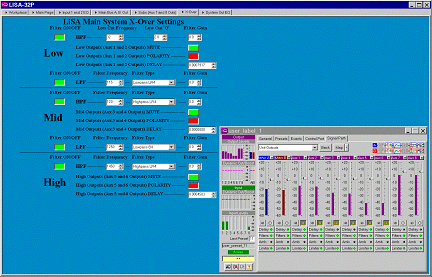 |
|
LiSA Technical Specifications
|
|
|
|
Frequency Response (+/- 3dB):
Horizontal Coverage (-6dB):
Vertical Coverage (-6dB):
Maximum Continuous Output:
Maximum Peak Output:
Signal Processing: |
32Hz – 18 kHz
90° Nominal, averaged from 315Hz to 16kHz
Varies with the size of the array and configuration
132 to 137 dBSPL, @ 1m
(Frequency/Bandpass dependent)
138 to 143 dBSPL, @ 1m
(Frequency/Bandpass dependent)
Crown USM810 digital system controller
or dbx 480 DriveRack |
|
|
|
|
Box Characteristics and suspension system
|
|
|
|
Box Construction:
Suspension system:
Input connectors:
Dimensions:
Weight:
|
8 degree (4° per side) trapezoidal shape
18-ply Baltic birch plywood enclosure.
Finished with high resistance textured paint.
Integrated AISI 304 Stainless Steel Hardware
equipped with AVK (R) 3/8” Stainless Steel
Quick release pins. 7:1 Load Safety factor
hanging up to 16 boxes. 10 box to box angle
combinations available.
Proprietary Stainless Steel Flying Bar, featuring
3 hanging points, reversible for stack mounting.
Neutrik Speakon (TM) NL8 type connector, 2 each.
(H x W xD) 620 mm x 1630 mm x 660 mm
140 kg each, including rigging frame. |
|
|
|
|
Transducers |
|
|
|
Low Frequency:
Nominal Impedance:
Input Power Rating:
Bandpass Sensitivity:
Mid Frequency:
Nominal Impedance:
Input Power Rating:
Bandpass Sensitivity:
High Frequency:
Nominal Impedance:
Input Power Rating:
Bandpass Sensitivity:
|
(2) x 18” (460mm) Woofer, 4” (100mm)
ISV Aluminum Voice Coil, DDR Flux Demodulating,
custom waterproof cones coating.
8 Ohms each, independently wired.
600W (AES) Continuous Power each,
6000W Peak.
99 dBSPL @ 1m, with 2,83 Volt, 1 speaker.
(2) x 10” (250mm) Midbass, 3” (76mm),
Overhung Aluminum Voice Coil, double
cone waterproof and damping coating.
8 Ohms each, parallel wired.
300W (AES) Continuous Power each,
1200 W Peak.
108 dBSPL @ 1m, with 2,83 Volt,
1 Speaker on horn.
(3) x Neodymium Ribbon Compact Drivers (TM).
13 Ohms each, wired in parallel.
60W (AES) Continuous Power each,
1000 W Peak (200ms).
107 dBSPL @ 1m, with 3,61 Volt,
1 Speaker on horn. |
|
|
|
|
|
|
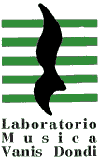 |
Laboratorio Musica di Vanis Dondi
P.A. & Lights Rent
Via Ponte Catena, 29/G
41016 NOVI DI MODENA – Italy
Tel. +39 059 677 455 Fax. +39 059 679 922
Mobile +39 335 802 8448
E-mail: laboratorio_musica@iol.it |
|
|
| LiSA Design Workgroup are: Mario Di Cola, Davide Doldi and Davide Saronni. They can be reached for any technical information about the system at the following e-mail address:
View Contacts |
|
|
|